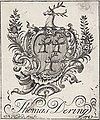Nathaniel Hurd
Nathaniel Hurd | |
|---|---|
 Portrait of Nathaniel Hurd by John Singleton Copley, ca.1765 (Cleveland Museum of Art) | |
| Born | February 13, 1730 |
| Died | December 17, 1777 (aged 47) Boston, Province of Massachusetts Bay |
| Occupation(s) | engraver and silversmith |
Nathaniel Hurd (13 February 1730 – 17 December 1777)[1][2] is recognized as the first American engraver and a silversmith in Boston, Massachusetts, in the 18th century.[3] He engraved "bookplates ... heraldic devices, seals, ... paper currency, and business cards" along with die engravers and engravers on copper.[4][5][1]

Early life and family[edit]
Hurd's grandfather had come from England and settled in Charlestown. He died in 1749 at the age of 70.[1]

Hurd's father was Jacob Hurd, a leading Boston silversmith, whose works are in the collections of the Peabody Essex Museum, Cleveland Museum of Art, Strawbery Banke Museum, and the Museum of Fine Arts, Boston. Jacob Hurd married a daughter of John Mason (of Kingston, Jamaica who died in 1758).[1]
Career[edit]
An obituary from Amos Doolittle noted Hurd was the first to have engraved copper in the USA.[1]
The lion rampant logo for Phillips Exeter Academy is taken from a bookplate Hurd designed for John Phillips in 1775.[7]
Works[edit]
-
Silver teapot made by Hurd in the collection of the Cleveland Museum of Art
-
Silver teapot forged and engraved by Hurd
-
Salver (tray)
-
Armorial bookplate
-
Trade card
Later life and legacy[edit]

Hurd died on 17 Dec 1777 and is buried in the old Granary Burial Ground in Boston.[1]
Examples of Hurd's work are in the collections of Harvard University; Yale University; Historic Deerfield;[8] the Lexington Historical Society; and the Museum of Fine Arts, Boston.
References[edit]
- ^ a b c d e f Scientific American. Munn & Company. 1869-05-08. p. 294.
- ^ Ward, Gerald W. R. (February 2000). "Hurd, Nathaniel". American National Biography. Oxford University Press. doi:10.1093/anb/9780198606697.article.1700439. ISBN 978-0-19-860669-7.
- ^ Charles Dexter Allen (1895), American book-plates, a guide to their study, London: George Bell & Sons, OCLC 1472039, OL 7058457M
- ^ "Portrait of Nathaniel Hurd by Copley." Bulletin of the Cleveland Museum of Art, Vol. 10, No. 3 (Mar., 1923)
- ^ American Broadsides and Ephemera, Series 1
- ^ Cummings, Abbott Lowell. "A Recently Discovered Engraving of the Old State House in Boston," Colonial Society of Massachusetts, 2017. (https://www.colonialsociety.org/node/774) Retrieved August 2018.
- ^ "The Exeter Lion Rampant". The Academy Archives. Trustees of Phillips Exeter Academy. Retrieved 11 January 2014.
- ^ "Five Colleges and Historic Deerfield Museum Consortium".
Further reading[edit]
- William Dunlap (1834), History of the rise and progress of the arts of design in the United States, New York: George P. Scott and Co., Printers, OCLC 812030, OL 6575532M
- Hollis French. Jacob Hurd and his sons Nathaniel & Benjamin, silversmiths, 1702–1781. Walpole Society, 1939.





